








LEARN THE BASICS

BOOTS & TRAIL SHOES
THIS SEASON’S CLOTHING
KIDS’ ADVENTURE GEAR
CLIMBING HARDWARE





TOP OF THE WORLD:
HIGH ALTITUDE TREKS
ADVENTURE MUMS:
LIFE AFTER KIDS
ALPINE TRAILS: RUNNING IN ISÈRE














Hello, and welcome to our 10th issue of Explore – a milestone for the magazine. As ever, this spring/summer edition is full of inspiration for your next adventure.
As spring approaches, the promise of warmer, brighter days has already got me planning. This season, I’ve got my sights set on running 50K, and Jen & Sim Benson’s piece about the Rocher Blanc Skyrace on p.46 offers some excellent motivation. If you prefer a slower pace but still want to push yourself, how about the Highlander event instead? Will Renwick shares his experience of the Lake District leg on p.34.
Always keen to improve my outdoor skills, I’ve also been brushing up on scrambling with the help of Calum Muskett (p.56). And having read our staff ’s favourite UK routes, a trip to Eryri (Snowdonia) is definitely on the cards this summer.
Looking to update your kit bag? With gear recommendations spanning everything from trail running footwear to backpacking stoves, there’s plenty in this issue to geek out on. As always, our full range is available online, and our shops are ready with personalised fitting services and the best advice.
See you out there.
04. DIARY: WHAT’S ON
ellis-brigham.com
Start planning for summer with our essential events calendar.
06. SPOTLIGHT
The Youth Adventure Trust is changing lives through nature.
08. TECH TALK: PERFECT FIT
Our in-store boot fitting service will elevate your comfort.
10. WALKING FOOTWEAR
This season’s must-have hiking boots from all the leading brands.
12. MOTHER NATURE
New mum Sian Lewis on mixing parenting with the outdoors.
17. KIDS’ GEAR
Get your little ones kitted out for a summer of adventure.
Proud






18. OUTDOOR CLOTHING
Stay warm, dry and comfortable in the latest technical garments.
22. HIGH AND MIGHTY
Legendary mountain treks to challenge and inspire.
32. BACKPACKS
Load up and go with these prize gear haulers.
34. SOLACE AND SATISFACTION
Will Renwick reflects on the timeless joy of a Lakeland walk.
40. BACKPACKING TENTS
Lightweight shelter for your next overnight adventure.
42. BUYING GUIDE: STOVES
Canister, liquid fuel, or stove system, here’s the lowdown.








44. BACKPACKING STOVES
The best of our portable backpacking stoves.
46. THE SKY’S THE LIMIT
A weekend’s trail running in the magnificent Isère.
53. TRAIL RUNNING GEAR
Lightweight essentials to keep you at the head of the pack.
54. FULL STRIDE
The latest in technical trail running footwear.
56. SCRAMBLING 101
Our how-to guide to launch your scrambling adventures.
59. KIT LIST
Must-have scrambling gear, from harness to helmet.





For more inspirational content and ideas follow us on Facebook and Instagram. We’d love to hear about your adventures – share them with us using the tag #ellisbrigham







61. MOVE ON UP
Our staff share their favourite UK scrambling routes.
64. CLIMBING KIT
Push higher with our newest line of gear and accessories.
66. LOCAL KNOWLEDGE
Bristol staffer Jay Doy goes out and about in the West Country.








Fort William: 19 - 22 September
Our inaugural Highland 200 promises to be a spectacular trail running event. A collaboration with Trail Events Co, the 200km (125mi) race sees entrants run between our Fort William and Aviemore shops.
Following parts of the lesser-known East Highland Way, the epic route is a journey through Scotland’s untamed wilderness. It’s a test of your strength and endurance but also a celebration of the Scottish Highland’s incredible landscape.
For more information and to book your place go to ellis-brigham.com/events.
Smartwool Second Cut
Covent Garden: 18 April
Get your Smartwool socks personalised, enjoy a coffee and learn more about how we’re working with Smartwool’s Take Back program to give old socks a second life. Throughout April, you can drop your old socks off in-store, helping keep valuable materials out of landfill and recycled into new products instead.
The BRITS
Tamworth: 11 May
Summer might be just around the corner but the skiing’s not yet over. Join us at the SnowDome in Tamworth for the stand-out event on the British Freestyle calendar. Hundreds of freeskiers, including established pros, aspiring amateurs, and first-time competitors, will take part to be crowned the 2024 slopestyle and banked slalom champions.
Trail Events Co
Wye Valley: 18 May
Eryri (Snowdonia): 6 June
Cotswolds: 17 August
Another year of fantastic races from the Trail Events Co gets underway, in locations from Lulworth Cove to the Lake District. We’ll be at each one, providing support, enthusiasm and event deals to help you to the finish.
Keswick Mountain Festival
Keswick: 17 - 19 May
Accompanied by The North Face, we’ll be at the Keswick Mountain Festival all weekend. There are plenty of sporting activities taking place, including guided hikes and runs, open water swims and a new adventure race. Live music will keep you entertained, while Nicky Spinks and David Millar are among the guest speakers.
Knowledge Nights
Bristol: 5 June
Manchester: 19 June
Kensington: 25 June
This summer sees a new series of events arriving in-store. Our Knowledge Nights will guide you through everything you need to know to take on epic challenges. We’ve partnered with EverTrek for the first three events, focusing on high-altitude expeditions.
Ellis Brigham Beacons Challenge
Bannau Brycheiniog (Brecon Beacons): 6 July youthadventuretrust.org.uk
Our annual hiking event raises funds for the Youth Adventure Trust (see p.6). A great team-building opportunity, the challenge has two routes available, taking on six or ten of the highest peaks in Bannau Brycheiniog (Brecon Beacons) National Park.
The Adventure Running Company
Chamonix: 12 - 15 September
Join us and The Adventure Running Company in Chamonix, one of the best places in the world for trail running. This four-day guided adventure is a fantastic opportunity to experience premiere mountain trails and soak in the iconic landscape while running in great company.
For more information, up-to-date listings and to book your place go to ellis-brigham.com/events

Getting outside can literally change lives. Ed Blomfield speaks to the UK charity empowering vulnerable young people through nature.
“The people who need the most resilience are the people who have the least opportunity to build it,” says Louise Balaam of the Youth Adventure Trust. “So that’s what we do. We find those young people that need the most resilience, and we enable them to face their challenges in a positive way.”
Operating in the Swindon and Wiltshire area since 1992 – and expanding into Somerset later this year – the Youth Adventure Trust uses the outdoors as a springboard for change in the lives of vulnerable children. The kids they work with are referred to them by local schools and agencies for any number of reasons. “Often they find themselves in difficult situations through no fault of their own,” explains Louise. “They might be really struggling at school; they might be bullied; they could be a bully; they might be living in extreme poverty; they might have parents who have drug and alcohol addiction issues, or who are in and out of prison; they might be young carers, or have health issues of their own. But the idea is that each young person goes on their own personal journey, and hopefully gains the skills and confidence to enable them to make more positive choices in their lives.”
Key to achieving those goals is the Trust’s long-term approach. Its flagship Adventure Programme takes children from Year 7 (just as they’re entering secondary school) and works closely with them for a full three years. Activities include hillwalking, camping, climbing, canoeing, raft building and much more. At the end of each year, the children embark on a multi-night expedition themed around the landscape –mountain camp the first summer, coastal camp the next (“a lot of them don’t even know how to swim, so that’s really challenging in itself”) and finally forest camp. Numbers are carefully limited to around 100 per year, which enables the volunteers and staff to nurture every individual – and as a testament to their efforts, very few children drop out.
“Given the nature of the young people that we work with, and the fact that it’s voluntary, it would be an easy thing for them to give up,” explains Louise. “Plus they often don’t have parental support. So we have to work really hard to get their families to buy into it, and for the kids to buy into it. But normally somewhere between 85 and 90% of the young people


who start our programmes finish them, which is amazing.”
It’s long been known that spending time in nature is great for people’s health – both physical and mental – but for Louise, the current younger generation can benefit more than most. “Coming out of lockdown and going back into schools, we’re seeing children with much more anxiety,” she says. “As well as just reaping the benefits of the outdoors, the activities that we choose specifically help them build different skills, like communication and teamwork. They learn to trust other people and work together.”
In some ways, the Trust’s Adventure Programme might sound similar to the popular Duke of Edinburgh Award, but there are several big differences. Firstly, it focuses on a younger age group with particular needs; secondly, it is a sustained approach that involves much more one-to-one support – from personal mentoring to help with transport and equipment. Lastly, and crucially, it’s unconnected with school life. “We don’t want them to bring the playground politics with them,” says Louise. “We want them to have the opportunity to develop as an individual and achieve their own objectives without the worries of peer pressure.”
While the children all take part for free, the cost of running these outdoor programmes is significant –approximately £3900 per head for the full three-year


“The Youth Adventure Trust uses the outdoors as a springboard for change”
curriculum. To continue operating, the Youth Adventure Trust therefore relies on an army of over 200 volunteers and holds regular fundraising events like the Beacons Challenge. Their ‘Sponsor an Adventure’ initiative also enables donors to directly support a young person on their journey.
In the three decades the Trust has been operating, it has produced countless success stories. Many graduates of the scheme are referred on to the DofE, local climbing clubs and so on, but more important to Louise and her colleagues are the soft skills that these vulnerable children gain.
“We can’t change their circumstances, but what we can do is change the way that they respond to those situations and give them the opportunity to be the person that they want to be.”
To find out more or donate, visit youthadventuretrust.org.uk


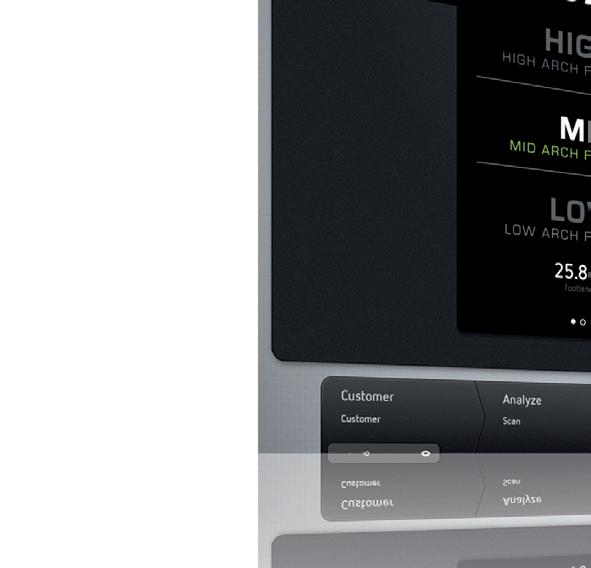



Getting your hiking boots fitted in-store – and selecting the correct footbed – will pay dividends on the trail. from our Stratford shop explains how technology is revolutionising the quest for comfort.
Why is it so important to get a ‘perfect
fit’ with hiking footwear?
Because your trip relies on your feet being comfortable. If your feet are in pain then the


trip stops.
Is it not enough just to find a boot that feels comfy straight out of the box?
If you're walking for two or three hours, you'll probably be fine. The problem is if you're walking for six hours every day for a week, or you're carrying a rucksack on uneven ground, because your feet will change during that time. It’s not the same as strolling across a tiled shop floor – there’s a huge difference.

also meant to fit everyone – they’re not meant to provide any sort of structure or support. It gives you a really good first impression of the boot, but the boot needs to be customised to make it fit your feet properly.
What kind of foot issues do customers typically present with?

Pronation; pressure and calluses on the underside of the toes; blisters at the heel; pressure on the top of the little toe… There's a wide range! It depends if they've got a wide or a narrow foot, if they have square toes, short toes, or feet that are different shapes or sizes.


What’s wrong with the insoles that come with the footwear?
They’re usually a more basic design, which helps keep the the boot affordable. They’re
How does the fitting process begin?
We've got around 20-25 boot models on the wall, and for some customers it’s really hard to make a decision. They’re often inclined to

choose based on the looks or colour rather than the actual shape of the boots, although just by looking at their feet while asking them some questions I’ll be able to start narrowing down the selection. Then when you get them out of their shoes and socks into bare feet, you can start to see any pressure points. After that, the Sidas Feetbox machine gives you more information about the profile, because you can't see the underside of the foot when they’re standing up. The machine can also measure each foot and really determine any difference. From there I’ll typically choose the two boots I want them to try on.



How does the Sidas machine work?
There's a pressure pad on the floor that the customer stands on, and a camera that points down at the foot from above. It gives an accurate scan of the foot to show the












volume, and a live pressure map so you can tell which parts of each foot are pressing down hardest when they're standing. There's a big computer screen right in front of the customer that presents all this information to them, so they can see exactly what the fitting expert is talking about. The machine will show you whether you’ve got high arches or low arches, and it will tell you the exact difference in the length and the width of your feet. And it actually gives a recommended insole based on those measurements.


Is there a treadmill element, like when you get your gait analysed for running shoes?
No. With road running you land in the same place on every single footstep. When you're hiking or mountain running, every step will be at a different angle, so you don't need specific gait analysis for off-road shoes.

a wide range of different foot types and activities. So there's a heavily cushioned one with a really thick gel heel and gel toes, which is for your casual footwear. Then there’s a lightweight low-profile one for hiking and running, which has got a little bit of cushioning. Next up is a stiffer, heavier outdoor insole for trekking and mountaineering boots. Plus within each range there are three different arch profiles (high, mid and low). Finally we have Sidas’s custom mouldable insoles – one for hiking boots and one for ski boots – which use a separate machine to take an imprint of your foot.
Are they expensive?
They’re around £40 to £45 for an off-theshelf insole, and then the mouldable ones are between £55 and £90 – the ski ones are more expensive because they have a carbon sole. The fitting process is free, you just pay the price on the box.

What do you do with the data from the machine?







If there’s a difference in size then I will fit the bigger foot first to make sure that's correct – because normally the smaller foot just has to follow along. And I can show the customer specific lacing techniques, or suggest a slightly thicker sock to get the fit correct on both sides. I've had customers who were two complete UK sizes different in length – like a 6 and an 8 – but with the right lacing and socks, I’ve managed to get both feet to feel secure.


Talk us through the insoles which the machine recommends.
Sidas offer a huge variety of insoles to fit



What have you learned from fitting so many boots?
We've done 10,000 scans of customers’ feet across the past year and a half. Sometimes they’ll move their feet to try to manipulate the scores and make their feet seem normal! But honestly, we’re all different – there's no such thing as a normal foot. It does not exist.

“WE'VE DONE

10,000 SCANS OF CUSTOMERS’ FEET ACROSS THE PAST YEAR AND A HALF”










AEQUILIBRIUM HIKE GORE-TEX
PRICE: £235 WEIGHT: 480G
Light and breathable yet robust and waterproof, the Aequilibrium Hike is a mid-height boot ready for action. La Sportiva’s Flex System provides mobility and support at the ankle, while the Vibram sole ensures traction and precision underfoot. Thanks to the resoleable tread, you can extend the life of your favourite boots and reduce environmental impact in one go.







PRICE: £225 WEIGHT: 590G
The classic design of Meindl's Peru boot pairs rugged performance with style; it also boasts a GORE-TEX membrane for reliable protection in wet conditions. The waxed nubuck leather upper guarantees durability, while the wide fit and Softstep footbed offer comfort on long days.




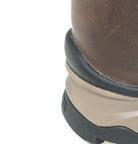






























PRICE: £180 WEIGHT: 530G
Wearable straight from the box, the Moraine blends hard-wearing nubuck leather and mesh in the upper for breathability, while a Scarpa Supergum outsole delivers reliable grip. A GORE-TEX bluesign membrane keeps your feet dry in the toughest conditions, and the built-in RECCO tag stands out as a great safety feature.




PRICE: £160 WEIGHT: 416G
The ever-comfortable Anacapa has been reimagined with a real focus on sustainability, incorporating a 30% sugarcane foam midsole, recycled polyester components, and a gold-rated Leather Working Group (LWG) leather upper. With masses of energy return on offer, these are real mile-munchers that will see you striding along with ease.

PRICE: £150 WEIGHT: 300G
The latest iteration of Merrell’s long-standing Moab family, the Speed is built for fast and light days, with 4mm Vibram lugs and a streamlined design that’ll carry you effortlessly over tricky terrain. FlexPlate technology offers torsional rigidity and forefoot stability, while the FloatPro foam midsole is plush and responsive for all-day comfort.






PRICE: £185 WEIGHT: 470G


Salewa’s technical mountain shoe offers robust comfort and waterproof protection. The innovative 3F System uses steel cables for a precise wrapping fit and ankle support, while to-the-toe lacing further enhances security.
The Vibram Alpine sole has aggressive lugs and dedicated climbing, traction and braking zones for complete control.




For women who lead active lives in the outdoors, parenthood presents a unique challenge. Sian Lewis meets four mums combining children with adventure.



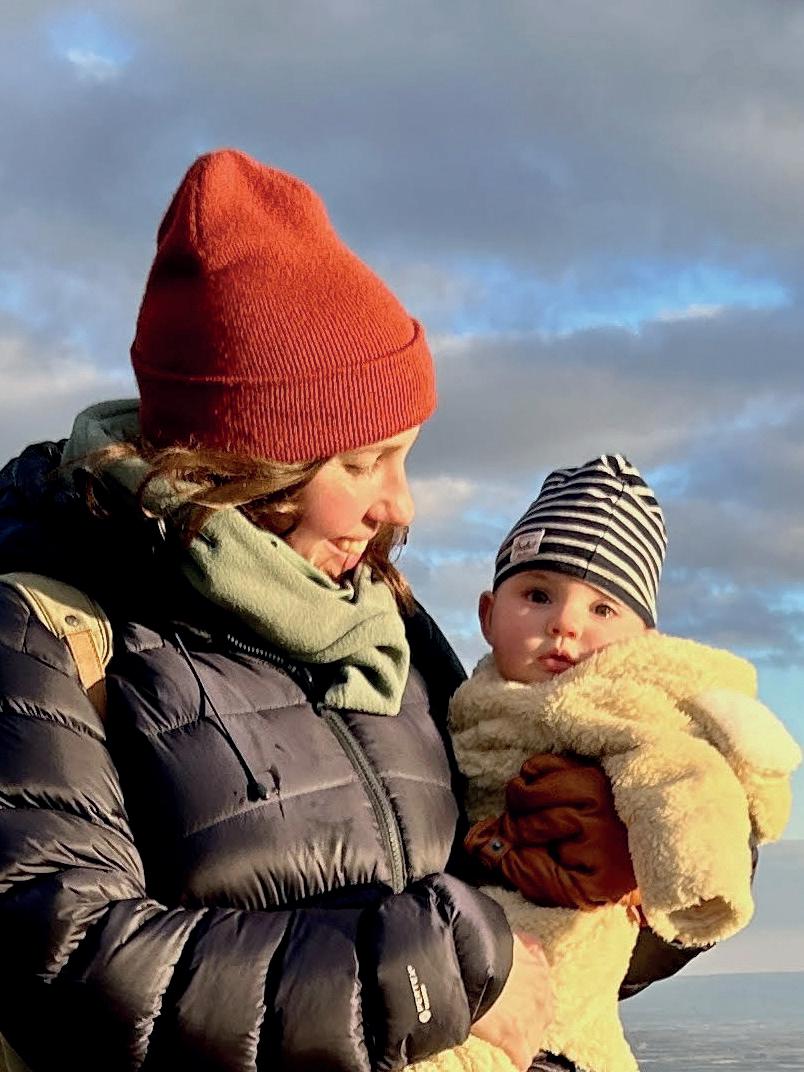






I wrote this article in fits and starts, in stolen snatches of time while my baby napped or was out being pushed in a buggy by her dad. It’s a far cry from how I once worked as a travel journalist, typing on planes, trains and occasionally even tents. While life has definitely changed since my fourmonth-old daughter Sylvie arrived on the scene, my love for nature and wild spaces is still strong – and combining that passion with the new love I have for a tiny human has been one of the biggest challenges – and joys – of my life.
When I was pregnant, I had a pretty easy time of things compared to many women, and travelled and exercised almost as much as ever. So it was a bit of a shock to switch to a more sedentary routine when Sylvie was a brand-new baby. I wouldn’t change having my daughter for anything, but in the first few months after she was born I found it hard to be inside, watching the last of the balmy autumn sunshine slip away and cold winter set in as I rocked and fed a baby, unable to just pop on my hiking boots and get outside whenever the mood took me.
In those first foggy days of motherhood, I also discovered that it’s still pretty hard to find examples of adventurous mothers in the mainstream media – women who have children but still challenge themselves in wild spaces; who play sport; or who work in the outdoors professionally (as I do). Sure, there are a few celebrity examples that hit the headlines. If you want to see mothers smashing their sporting goals, there’s Serena Williams winning the Australian Open while pregnant, or mother-of-five Sophie Carter, who won a 100K ultra despite stopping half-way to use a breast pump. But these women are typically held up as the exception to the rule.
Luckily, there are plenty of active mamas changing that picture on social media, sharing how they both work and play outdoors – fitting hiking, travelling, sports coaching and more around their babies. I set out to speak to a few of them.

In 2024, it still feels like it’s more difficult to be an outdoorsy mum than a naturemad dad. I don’t remember anyone asking my husband how he planned to juggle parenthood with work and sport, but I’ve had to field that question again and again.
Hetty Kingston (@hettykingston) is one of the organisers of the Peak Gravel Gang cycling group and was a director of the Women’s Trad Festival. She’s also mum to eight-month-old twin girls Annie and Flo.

“There’s still a lot of societal pressure and ‘norms’ placed on mothers to take on the care of children,” she says.
“Sadly, the phrase ‘mum guilt’ is a real thing, while the phrase ‘dad guilt’ really isn’t ever used – [though] I’m not saying it’s not felt!” Hetty regularly takes her twins outdoors on her own, but reports that “people express surprise when they come across me hiking solo or taking the twins out in the bike trailer off-road”. It begs the question: would a father receive the same kind of feedback?
Speaking personally, the main obstacle I’ve experienced is the unavoidable physical side of motherhood. Most women need six weeks to recover from even the most straightforward birth, and three months before they can start more strenuous activity. Breastfeeding, if that’s how you choose to feed your baby, is an incredible bond with your little one, but it does present challenges – you and your boobs can only be separated from your baby for 3-4 hours at a time.
In some ways, of course, breastfeeding doesn’t need to limit you at all, especially when your mini-me is small and portable –they can simply come too. For Sylvie and me, walking has always been our thing. She’s probably been on 40 proper walks in a carrier despite only being on the planet for 100-odd days, and while a few have gone pear-shaped (most notably when I attempted to walk the Mendip hills and
she screeched with rage for an hour and a half), many more have been fabulous, with Sylvie staring with wonder at golden winter sunsets. They may be shorter and less epic than the mountain trails I used to tackle, but in many ways these hikes are far more rewarding.
Zahrah Mahmood is president of The Ramblers Scotland and The Hillwalking Hijabi on Instagram (@the_ hillwalking_hijabi) . She’s mum to Harris, two, and always prioritises time in the outdoors. “My husband and I work during the week, so hillwalking is a weekend-based activity for us,” she explains. “It gives us something to look forward to. It can be a challenge to make time in nature a priority because it’s so easy to worry about getting on with the housework or cooking – as mums we put pressure on ourselves to get all aspects of motherhood right.” Her advice? “Remember that it’s ok to take time for you. If you’ve not done the washing or ironing, who cares? Go get outdoors for your own mental health – it’ll have a positive impact on your child, too.”

Athena Mellor (@ramble.family) is the author of two guidebooks, an outdoors content creator, and mum to Aífe, two. “I’ve chosen to involve Aífe in all my outdoor adventures,” she says. “Now she’s walking and talking, longer hikes are more of a challenge as Aífe wants to walk, but we’ve simply adapted our hikes to suit her. And it’s incredible to watch a child’s development in the outdoors – from touching things to tottering about to running across the mountains!”

Zahrah too finds fulfilment in watching her son discover the natural world. “The biggest joy has to be watching Harris interact with nature. I love seeing the confidence, the wonder, the curiosity the outdoors gives him. He examines things like sticks, leaves and pine cones that I’d walk straight past.”


“Longer hikes are more of a challenge as Aífe wants to walk, but we’ve simply adapted them to suit her”





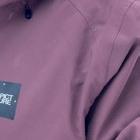
And what about when sport is your job? Olympic gold medallist, snowboarding coach and presenter Jenny Jones (@ jennyjonessnow) is mum to Wilbur, six months, and runs winter snowboarding workshops. She’s adapting her schedule to make things work as a family. “I’ve run one snowboarding workshop so far in Tignes in France and Wilbur came with me. A friend looked after him for a few hours each day while I went riding with my clients, and I spent the afternoons with Wilbur while my head coach carried on the adventures with the group.”
Then there’s adventuring without your kid in tow. I make it a regular priority to leave Sylvie with her dad for a few hours while I go running and hiking alone; at other times, they’ll take up lifeguard duty, standing on the shore while I swim laps at the open water swimming lake. Jenny, too, splits up some of her outdoor time: “On a weekend my partner and I take turns to surf for an hour each. The amount I surf and snowboard is a lot less than before Wilbur arrived – but I’m absolutely fine with that. When I did finally go surfing after eight months of patiently
waiting, it was the most wonderful feeling in the world. And no, I didn’t surf particularly well – I wobbled all over the place! But to just be in the water was everything.”
If you’re reading all of this with a baby on the way, take heart – the mothers I spoke to all stressed that the outdoors was a wonderful way to connect with both their child and the new ‘mum’ version of themselves. “Be kind to yourself,” advises Athena. “This is a huge transition, both mentally and physically. Personally, continuing to get outdoors allowed me to feel like myself when everything else seemed to change. It was amazing for my physical and mental health and also allowed me to make some great outdoorsy mum friends. Being outside has so many benefits for our little ones, too.”
“Take baby steps,” says Hetty. “You’ll get there! Just like any good adventure, planning something with your baby might seem totally unrealistic at first, and there will be bumps along the way. Progress isn’t linear!”
Jenny agrees. “There’s no rush at all to return to sport and travel; remember you will eventually get back to the things you enjoy. On the more practical side, I’d recommend speaking to a specialist physio in women’s health after birth. Then start small and build






up – even a quick run will feel great if you haven’t exercised for ages!”
I’ve been surprised by the welcoming community of adventurous local parents I’ve connected with since having a baby. There are myriad walking groups you can join, and I now have plans to go winter swimming with one mum and to hike with another. As Jenny puts it: “Teaming up with other mums is a great place to start with a new baby. Then you can start looking to the mountains.”

“I snowboard less than before Wilbur arrived, but I’m fine with that”

















PRICE: £65
Kids need a decent rain jacket for the school run and weekends spent playing outdoors, and the Antora ticks both of those boxes.
A waterproof DryVent shell and PFC-free water-repellent finish combine to fend off the elements, while an ID label stops it from getting lost.







PRICE: £35
Durable and comfy, this Odlo base layer provides the perfect foundation for their outdoor layers. Made from 100% recycled polyester with a soft brushed inner, it also has a ZeroScent odour-resistant treatment to keep things fresher for longer.










PRICE: £350
A fully functioning child carrier for the outdoors, the Poco has a breathable AirSpeed back panel and a comfortable harness to maximise comfort for both parties. A UPF 50+ sunshade, plenty of pockets and a detachable raincover finish the ensemble.
PRICE: £60
A go-anywhere hiker for kids, the Moab 3 Mid offers excellent protection for young feet. Durable and comfortable, the waterproof construction, soft foam midsole and traditional lace closure come together to be far more than just the sum of their parts.









PRICE: £60






PRICE: £29
Osprey made the Jet so kids can carry their outdoor kit and trail treasures in style. Its 12-litre capacity has room for layers, snacks, and drinks. Highlight features include hydration bladder storage, stretch mesh stash pockets and padded straps for allday comfort.
An excellent water bottle for kids, this keeps drinks cold for 24 hours and is durable enough to withstand roughand-tumble play. A small-hand-friendly silhouette and carry loop combine with the easy-to-use flip straw lid to keep them drinking on the go.


MEN'S LATOK
GORE-TEX PACLITE
PLUS JACKET
PRICE: £250
A versatile and lightweight mountain shell, the Latok is made from 2.5-layer GORE-TEX Paclite, making it waterproof, windproof, breathable, and eminently stowable. Climbing-ready, the hood fits over a helmet, articulated sleeves give arms-up mobility, and underarm vents are on hand to counter shifts in the weather and moments of exertion.


MEN'S VIDDA PRO TROUSERS
PRICE: £180
Fjällräven’s G-1000 Eco fabric is an industry byword for hardwearing and robust, and the Vidda Pro trousers use it to great effect. The articulated knees and reinforcements in highwear areas add to a deserved sense of durability, while the well-thought-out pockets mean there’s storage aplenty.

PRICE: £90
Excellent softshell trousers that’ll tackle technical terrain with ease, the wind and water-resistant Ibex are outdoor all-rounders. Equipped with five zipped pockets - the thigh pockets include integrated mesh for venting on more challenging ascents. An alpine fit keeps you mobile and means there’s no excess material flapping around.










PRICE: £40
A perfect base layer for alpine adventures, the Lightning tee is equipped with FlashDryXD fabric technology for fast wicking, as well as being made from a polyester/elastane mix for comfort and durability across multi-season use. A crew neck design and offset shoulder seams add to the everyday comfort levels.




PRICE: £190
A classic insulated jacket, the Nano Puff is lightweight and compressible. It's packed with PrimaLoft Gold Eco synthetic insulation, which is 100% post-consumer recycled polyester. The face fabric has a water-repellent treatment to fend off wind and weather, while you also get comfy zipped hand warmer pockets an internal zipped chest pocket.

PRICE: £400
The Beta LT is a favourite for hiking, offering robust weather protection thanks to the bluesign approved 3-layer GORE-TEX fabric. Anatomical shaping and a tricot lining make movement free and easy, even with a pack on. Highlights include a helmet-compatible StormHood, roomy hand pockets, and underarm pit zips that let you vent excess heat fast.
















PRICE: £90
Based on the excellent Protium Hoody, this Lite version cuts down some of the weight without compromising performance. With a high collar and under-helmet hood on offer, it delivers flexible warmth whenever you need it, while a Polygiene treatment tackles odours on longer adventures.



















PRICE: £120
Stylish and warm, this Patagonia mid layer features jacquard fleece with hollow-core yarns and a unique zigzag texture. It's quick drying and ideal for high-output activities, it has embedded odour control, and the off-shoulder seams ease pack carrying. As you'd expect from Patagonia, it's made from bluesign approved fabric and is Fair Trade Certified sewn.


MOUNTAIN EQUIPMENT WOMEN'S MAKALU GORE-TEX JACKET
PRICE: £300
A classic mountain shell, the Makalu now features the PFC-free GORE-TEX expanded polyethylene (ePE) membrane with a 75-denier recycled face fabric that cuts its carbon footprint while remaining durable and protective. Mountaineeringfriendly elements like the helmetcompatible hood, harness-compatible pockets, and water-resistant zips round out a potent package.



MOUNTAIN EQUIPMENT WOMEN'S COMICI AC PANT
PRICE: £90
Hardwearing and weatherresistant, but still breathable and stretchy, the Comici is a great choice for long days outdoors in varied conditions. Fabricated from Exolite 125 softshell, they’ll fend off wind and moisture, and dry fast too. A women's active fit with slim ankle makes them perfect for technical, mountainous terrain.


PRICE: £110
Top-quality outdoor tights are an essential across the seasons, offering stretchy leg protection that can be layered up or down to suit conditions. A high-rise waistband provides increased coverage, and a combination of zipped and drop-in pockets give plenty of phone storage options. Flat-seamed construction and a PFC-Free water-repellent finish round out this versatile package.




















PRICE: £35
Simple but highly effective, the Dart does everything you’d want from a base layer tee. Made from breathable 100% recycled Apex Eco fabric with a Polygiene antimicrobial odour treatment, it will wick moisture and help regulate temperature on the hottest of ascents. Low-profile seams help prevent chafing even on longer adventures.














PRICE: £110
Light, super-warm and flexible, the Bolt is made from slimline Polartec PowerGrid fabric that optimises wicking and traps heat while remaining breathable and low-bulk. The lowprofile hood fits under a helmet, while thumb loops help keep your wrists warm. Zipped pockets are present and correct, and shoulder seams are offset to avoid friction under a pack.
PRICE: £270
Featuring a 30 denier NetPlus face fabric made from recycled fishing nets and a 3-layer H2No Performance Standard waterproof/breathable barrier, this lightweight shell will keep you dry and comfortable as you hike. A regular fit allows layering to suit all seasons, pit zips enable quick venting, and the jacket stows into the chest pocket for the ultimate in packability






PRICE: £65
An understated essential, this half zip fleece does its duty whether you are up a mountain, under canvas, or just out for a Sunday stroll. Made from AdvancedSkin Warm, the bluesign approved four-way stretch fabric keeps you warm, wicks away moisture, and has a soft brushed back for extra comfort points too.












PRICE: £130
A lightweight insulated layer for all seasons, the Cirrus Flex packs PrimaLoft Silver Luxe synthetic insulation into a streamlined microbaffle design. Protected by a windproof Pertex Quantum outer, Thermic stretch fleece side panels enhance breathability and give a lowbulk fit. The insulated collar stops chills and zipped pockets keep your essentials safe.

Tristan Kennedy explores six of the world’s best high altitude treks.
High altitude trekking is a great way to immerse yourself in alpine environments without the need for technical climbing skills or a ton of expensive gear. You can soak in the same solitude that mountaineers like to wax lyrical about, and see many of the same spectacular landscapes, while facing just a fraction of the risks. That’s not to say trekking isn’t difficult – spending days or even weeks out on the trail is its own, unique challenge. But the rewards are worth it. All of the epic treks listed on these pages come with bragging rights included – and a guarantee that the hot hotel shower at the end will be one of the best you’ve ever taken.


190km | 11,685m total elevation gain | 15-19 days
We could have included the Everest base camp trek on this list, but the Annapurna Circuit offers more varied scenery, is often less crowded, and is arguably just as challenging. There are several variations, but most people drive from Kathmandu to the village of Besisahar, and work their way anti-clockwise around the Annapurna Massif, finishing in Pokhara. From there, you can catch a stunning (if sketchy-feeling) flight back to the Nepalese capital. Accommodation is generally in teahouses, which offer warm tea, an even warmer welcome, and delicious Nepalese dahl-based dishes for dinner. The altitude is the main thing to consider here; you go from just under 1,000m above sea level to the 5,416m-high Thorong La Pass, so it’s important to take time to acclimatise. But the views are like nowhere else on Earth.
“It’s important to take time to acclimatise. But the views at Thorong La Pass are like nowhere else on Earth”

Every step made lighter.
VEIL 12L RUNNING VEST
Lightweight, and built to last. Our gear is engineered to help you get the most out of the outdoors.

WWW.RAB.EQUIPMENT

82km | 4,900m total elevation gain | 7-8 days
Generally recognised as the easiest of the Seven Summits, Kilimanjaro is sometimes written off as a climb for gap year travellers and charity fund-raisers. If you’ve completed the London marathon dressed as Pikachu, you might think climbing Kilimanjaro is next on the list, but this belies the seriousness of the challenge. At 5,885m, the summit would be significant wherever it was in the world. The fact that it’s the world’s highest single freestanding mountain, and that the trek starts from just 1,000m above sea level, means you really feel the effects of altitude here. It’s true that there’s no rope work or technical climbing ability required to reach the main summit, and 82km is not very long as the crow flies. But this is still a tough trek, and unless you’re taking the Marangu route, where there are huts, you (or your team) will be carrying tents and camping gear. You can climb it in five days, but most take seven to eight, to allow for acclimatisation.


“The fact it’s the world’s highest free-standing mountain, and that the trek starts from just 1,000m above sea level means you really feel the effects of altitude here.”

130km | 3,000m | 8 days
High altitude treks are all about getting off the beaten track, and there are few that’ll take you further than this multi-day hike in Kyrgyzstan. Khan Tengri is the highest mountain in the Tien Shan range, which straddles the border between Kyrgyzstan and its neighbour Kazakhstan. It’s the world’s most northerly 7,000m peak, and while it’s relatively popular with climbers from the former-Soviet countries, it only gets a fraction of the traffic of equivalent mountains in the Himalayas or the Karakorum. This trek to the basecamp, up the stunning Inylchek glacier, offers an amazingly uncrowded alternative to the popular treks that many undertake to the base camps of Everest or K2 in Nepal and Pakistan. Most tour groups start in the town of Karakol – Kyrgyzstan’s answer to Chamonix – and finish off with a night on the shores of Lake Issyk-Kul, home to some of the most beautiful high altitude beaches in the world.


“Khan Tengri is the world’s most northerly 7,000m peak, and it only gets a fraction of the traffic of equivalent mountains in the Himalayas”


160km | 11,300m total elevation gain | 13 days
Mountains don’t get more stunning than the Dolomites. Covering much of the regions of Trentino-Alto Adige and Veneto in northeast Italy, this sub-range of the Alps is characterised by near-vertical pinnacles of red rock sticking out of forested, green foothills. The trek starts in the German-speaking town of Brixen, takes you through the stunning Pale di San Martino, Marmolada, and Sella massifs, and finishes in the town of Feltre 13 days later. As well as its sedimentary cliffs, the Dolomites are famous for its via ferratas – climbing routes bolted with steel ladders and safety cables to make them more accessible – and the Alta Via 2 features several highly-exposed via ferrata sections. Accommodation is in mountain huts, which serve up reliably delicious three-course dinners (this is Italy, after all). Of the four classic Alta Vias (or “high roads”) that cut through the Dolomites, this route, which never drops below 1,300m, is the most challenging. Not for nothing is it known as the High Road of Legends.


221km | 15,200m total elevation gain | 12-14 days
The original high altitude trek – and still one of the best –the Haute Route or “high road” between Chamonix and Zermatt was pioneered by tweed-suited members of the British Alpine Club in the 1860s. At the time, the golden age of alpinism was in full swing, people like Edward Whymper were picking off the last major summits on the continent, and alpine tourism was a burgeoning business. Although it’s technically challenging (and would have been even more so with 19th century equipment) this route, which connects the two epicentres of Victorian mountaineering, has proved enduringly popular. It remains a favourite with both summer hikers and winter ski tourers, and the main mountain refuges are often booked up months in advance. The highest point on the classic version is just 2,987m, but the 15,200m of total elevation gain, and the amount of time you spend on glacial terrain, mean it’s a significant undertaking.
“The Haute Route or ‘high road’ between Chamonix and Zermatt was pioneered by tweed-suited members of the British Alpine Club”
270km | 14,768m total elevation gain | 23-25 days
Known as ‘the Land of the Thunder Dragon’, Bhutan is a tiny kingdom high in the Himalayas that sounds like it’s been lifted from the pages of a fairytale. It’s one of the world’s few carbon-negative countries (its forests absorb more carbon than its population produces), and the only place in the world to have a national park dedicated to preserving the habitat of the yeti – just in case the mythical creature exists. To discourage overtourism, and make sure visitors contribute in a meaningful way to the local economy, the Bhutanese government charges a Sustainable Development Fee – essentially a tax on tourists – of US$100 per day. The upside of this, from a visitors’ point of view, is that the trails are often empty, especially compared to those in nearby Nepal. The Snowman Trek is the big daddy of Bhutanese adventures – a 270km hike through some of the country’s most stunning scenery, including the world’s highest unclimbed mountain, Gangkhar Puensum. It’s the very definition of epic.









In 1974, our rst stiches were placed, initiating a legacy of meticulous cra manship.




A half-century later and we’re just as passionate about inspiring your next adventure as we’ve always been.

















































PRICE: £375 WEIGHT: 2.2KG







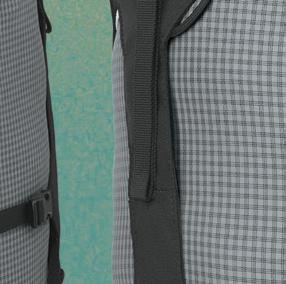































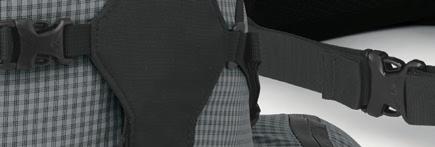



OSPREY MEN’S AETHER PRO 75






Streamlined and technical, the 75-litre Aether Pro excels on extended backpacking trips. With strippable features and a customisable carry system, you can fine-tune the pack to meet your needs exactly. A vertical side zip offers easy access, while compression straps ensure stability. Its bluesign approved NanoFly fabric with ripstop reinforcement gives outstanding durability.















































WOMEN’S












PRICE: £240 WEIGHT: 0.9KG









When light is right, the Eja Pro comes into its own. A 55-litre pack, its low weight doesn’t compromise the offering here. The AirSpeed tensioned mesh back panel provides ventilated comfort, while the women’s specific harness gives custom support. Save grams by removing the lid and side straps; a hydration sleeve and multiple pockets maintain functionality.







PRICE: £220 WEIGHT: 1.9KG


With a 55-litre capacity, the Zulu is ideal for short backpacking trips. Its front U-zip opening gives speedy access to the main compartment; the zipped base section is ideal for holding your sleeping bag. The carry system includes Gregory’s FreeFloat dynamic hip belt, which conforms to your body for plush comfort.



MEN’S AETHER 65
PRICE: £270 WEIGHT: 2.2KG





















WOMEN’S SIRAC ND65
PRICE: £150 WEIGHT: 1.9KG


Osprey’s 65-litre Aether is a backpacking classic. Comfortable to carry however heavy the load, its adjustable, ventilated AirScape back system gives personalised support. Top, front, and base access options make packing and storing kit a breeze. An integrated raincover keeps things protected when the clouds roll in.
A Lowe Alpine favourite, the Sirac ND65 layers practical features on top of a women’s specific carry system tailored to a smaller frame. The Air Contour X back system is fully adjustable and includes ventilated cutouts for cooling comfort. The extendable lid increases capacity from 65 to 75 litres, and there’s an integrated raincover for all-weather use.













WOMEN’S










PRICE: £235 WEIGHT: 1.7KG
The women’s specific Aura AG LT remains lightweight despite the broad feature set. Its top lid and zipped side panel access aid packing and organising, while stretch pockets let you stash gear on the go. Its 50-litre capacity makes it ideal for shorter backpacking trips; removable camping mat straps, pole attachments, and a raincover provide flexibility.































“Why does a man climb mountains?” mused Alfred Wainwright, one of the most famous of writers to document the landscapes of the Lake District. “Why has he forced his tired and sweating body up here when he might instead have been sitting at his ease in a deckchair at the seaside?”





Similar questions run through my head as we crouch behind the meagre protection of a dry stone wall while lightning flashes above us and thunder booms from the ash black clouds. Rain drips down off my nose, rendering the navigation app on my phone unusable. Until this point, everything had been going so well.
I’d come to the Lake District with my partner, Hannah, and our border terrier, Griff, to take part in a hiking event called HIGHLANDER. Held in locations throughout the globe, this version in the Lake District sees participants tackle distances of either 99, 56 or 20 km. Walkers can go at whatever pace they choose but are encouraged to take things slowly and to absorb the natural beauty along the way. Each evening, the whole group will rendezvous in a remote setting – typically a farmer’s field with portaloos and a field kitchen. All food is provided, mountain safety teams are on hand throughout to ensure everyone gets from A to B safely, and there are evening talks and workshops to take part in too.
We’d opted for the 56 km distance which would see us travel from Great Langdale to Borrowdale, then along the length of Derwentwater and onto Pooley Bridge.
“Where exactly does the path go?” asks Hannah as we make our way from the start line and head through Great Langdale towards the valley’s terminus – where a seemingly unscalable slope looms. Squinting my eyes, I can just about pick out the zig zagging path up to the top of Rossett Pike. In less than a kilometre we’d need to go from 140 metres to 606 metres – quite the baptism of fire. The cluster of 60 or so hikers who we’d set out with have dispersed in no time, with the fittest of the fit flying ahead and the dawdlers like Hannah and myself falling behind while we stop to shed layers, take pictures and catch breaths.
As is often the case in the Lake District, hard work on the legs reaps rewards. Cresting the top of the col, we are immediately introduced to Lakeland’s giants with Esk Pike, Great End, Great Gable and none other than Scafell Pike crowding our horizon; crag-sided hulks formed by ancient uplifts in the Earth’s crust. After following a winding path through the lake-dotted mountain upland, we’re soon following the sound of white water downhill into the idyll of Borrowdale, one of the finest valleys in the Lake District.
There are many great feelings in life –noticing the first sign of spring, seeing your sports team triumph, bumping into an old friend you haven’t seen in years – but none of these come close to the feeling of that first pint after a long and demanding day of hiking – especially when it comes from a Lake District pub. Sure enough, the refreshments in Borrowdale don’t disappoint. We head first


to the youth hostel, which has a bar room that could be mistaken for an alpine refuge – replete with pinewood decor, external frame backpacks adorning the walls and the company of many other satisfied walkers, all ready to exchange stories from the day. Then there’s the Langstrath Inn, where we’re cheered into the sunny beer garden by a large gathering of high-spirited HIGHLANDER hikers; friends we’ve made throughout the day and who’ve come from as far afield as Norway, Poland and Croatia for a taste of Lakeland’s world renowned beauty.
They say that the best way to help a hangover is to avoid drinking in the first place. That’s solid enough advice. The second best way is to swim in a Lake District river – ideally the Derwent. It seems to work for me. With its gentle flow (at least on this occasion), deep pools of clear water to sink into, and banks lined by twisted ancient oaks and a jungle of ferns, this part of Lakeland has a mystical feel to it and, swimming here in the sunshine is a gift to the senses. I’ll tell you what’s not a gift to the senses, though: Keswick town centre on a sunny, muggy afternoon in the middle


The HIGHLANDER event includes some challenging climbs, but walkers are encouraged to go at their own pace.

“In less than a kilometre we’d need to go from 140 metres to 606 metres –quite the baptism of fire”

“The hikers have come from as far afield as Norway, Poland and Croatia for a taste of Lakeland’s world renowned beauty”


of the school holidays. After hiking along the entire 5 km eastern shore of Derwentwater, we reach the town to find it heaving with tourists, with lines of queues for ice cream pouring out of cafe doors and narrow streets choked by thickset campervans.
There’s a reason there are lakes in the Lake District, and that evening a ferocious storm moves in – the same one that has us crouching behind a dry stone wall questioning the ‘why’ of hiking. I’ve come to accept that barring a huge stroke of luck, any backpacking trip in the UK – whether it’s in the Lake District, the Highlands or Eryri – will come with some bad weather. In fact I almost embrace it, because once you get through these hard moments, the good times – the ones you’ve had to earn – feel absolutely superb.
Sure enough, less than an hour later we are reminded of exactly why we’d chosen to come here. Just as we reach camp, the clouds make way for sunshine, and one by one, nowfamiliar faces from the trail begin emerging from their tents. For one set of hikers from the Middle East, the rain has cleared just in time for them to face down the valley, towards Mecca, and begin their evening prayer. Soon,

the evening light paints the surrounding fells in golden hues while steam gently rises from my camping stove and the burner quietly hisses away. I’ve lugged a few bottles of beer –named after Alfred Wainwright himself – in my pack throughout the day and, while I’d cursed that decision a few miles back, at this point in time it feels like one of the finest choices I’ve made in life.
While admittedly very gender exclusive, that question posed by Wainwright (“why does a man climb mountains?”) is actually just a small excerpt from a larger quote by the famous rambler. “More and more people are turning to the hills,” he muses (and bear in mind this was written in 1960; it’s arguably even more relevant today). “They find something in these wild places that can be found nowhere else. It may be solace for some, satisfaction for others: the joy of exercising muscles that modern ways of living have cramped, perhaps; or a balm for jangled nerves in the solitude and silence of the peaks; or escape from the clamour and tumult of everyday existence.”
Solace and satisfaction, exercise and escape; from the start in Great Langdale to our eventual finish at Pooley Bridge (having spent the final day walking a dramatic skyline route along the dog-legged expanse of shimmering Ullswater) our three days in the Lake District certainly had all of the above. And on the road back home, with work and daily chores on the horizon, the possibilities of future adventures in the fells swirl around in my mind. Lakeland – it’s always calling.






































MSR HUBBA HUBBA NX
PRICE: £540 WEIGHT: 1.72KG







MSR’s Hubba Hubba NX is the definitive two-person backpacking tent. It hits the sweet spot between durability and weight, exploiting an ingenious pole configuration for extra space in the living area. A freestanding model, porches on either side make access and gear storage easy. Practical and adaptable with a small pack size, there’s a lot to like in this three-season number.








PRICE: £425 WEIGHT: 3.30KG
The F10 MTN 2 has a freestanding geodesic design that guarantees stability and makes it easy to set up, even on rocky ground. The tent pitches inner first and has fully taped seams and a bathtub groundsheet to enhance wet weather protection. Sized for two, there’s a main vestibule at the front for gear and another door at the back for quick access.








PRICE: £440 WEIGHT: 3.20KG









The Tindheim is a roomy three-season, two-person tunnel tent with a generous porch and decent headroom to boot. Its twin-hoop configuration and flysheet first setup make it easy to pitch regardless of the weather. Good ventilation thanks to the flysheet vents, a built-in laundry line, and internal pockets amp up the liveability.



























PRICE: £1,110 WEIGHT: 2.90KG







Strong yet light thanks to its tunnel construction, the Nallo 2 GT delivers pinnacle all-season performance. An investment in top-quality materials and practical, proven design results in a two-person model you can truly use year-round. The tent pitches in one for speed and weather protection; an extended porch ensures room for all your gear without blocking access to the inner tent.





WEIGHT: 1.14KG



Part of our ultralight backpacking collection, the Hornet OSMO 2 boasts Nemo’s forensic attention to detail. A semi-freestanding, two-person tent, its small pack size belies the practical space when pitched, with two doors and vestibules offering essential gear storage. The flysheet uses Nemo’s OSMO ripstop fabric, made from 100% recycled yarns with a PFC-free water repellent finish.











PRICE: £480 WEIGHT: 1.13KG


The technical wizardry of Big Agnes is on full show in this two-person, semi-freestanding tent that weighs just over a kilo. With a focus on keeping weight and pack size to a minimum, the Tiger Wall UL2 is best suited to fast and light adventures in the milder months. Two doors and vestibules make living conditions relatively palatial, as do the media pockets and internal gear loft.




A good camping stove is an outdoor essential. You can warm up and hydrate with a quick trail brew, or re-fuel with a nourishing meal after a long day on the move.
Backpacking stoves tend to be the lightest and most compact versions on the market, perfect for carrying over long distances. But fear not: their smaller dimensions don’t mean a drop in performance. Powerful and efficient, they’ll cover all your needs on multi-day trips.
We split backpacking stoves into three basic types: canister, liquid fuel and stove systems.



These small, lightweight stoves work with screw-thread canisters containing pressurised gas. Their versatility and stowability make them ideal for backpacking trips.
Most canister stoves screw onto the top of the gas canister. Others sit low to the ground, connecting to the fuel source via a fuel line. These designs offer better stability – ideal when cooking in difficult conditions or on uneven terrain.
Some canister stoves have auto-igniters, making them quick and easy to light.
Other models need a match, lighter, or fire steel to get them started. Once lit, you can use the simmer-control function to adjust the flame as needed.
• Quick and convenient to use, with fast set-up
• Compact, lightweight, and easy to carry
• Good value for money
The workhorse of the stove world, liquid fuel stoves will perform in all conditions. This makes them ideal for longer backpacking trips, expeditions, and mountaineering.
Instead of a pressurised gas canister, they connect to a fuel bottle. It gives you the flexibility to switch fuel types to match availability. White gas, paraffin/kerosene, and unleaded petrol are common choices. While liquid fuel stoves need priming before use and more maintenance, they will give superior economy over longterm use. To improve the efficiency of a liquid fuel stove, you can use a windshield, which helps to shelter the flame and increase heat retention.
• Perform reliably in any condition, temperature, or altitude
• Will work with a range of liquid fuels
• Cheap and widely available fuel

A sub-division of canister stoves, these systems feature an all-in-one design. The burner screws onto the top of a gas canister, and the cooking pot screws onto the burner. When it’s time to pack up, the components stow within the main pot to keep pack size to a minimum.
Stove systems are all about efficiency; they’re best used for boiling water fast. So, if you’re looking to heat water for hot drinks or a dehydrated meal for one, they’re a top pick.
The pots they work with are modelspecific and tend to have high sides and a narrow base. This can make frying ingredients or simmering sauces tricky, and means they work best on flat ground.
• Combined stove and pot for all-in-one convenience
• Compact, space-saving designs
• Fast and very fuel-efficient
Carrying the right amount of fuel for your camping trips can be tricky. Too much, and you’ve got a heavy pack for no reason, too little, and you risk having a cold dinner. Before your next adventure, it’s worth doing some research (and maths) to get a better idea of how much you should take. As most backpacking meals require boiling water, the first step is to work out how much water you’ll use. Detailed meal planning is the best way to do this, but as a basic guide, use one litre of water per person, per meal. Once you’ve confirmed water quantities, use your stove’s boil and burn times to calculate how much fuel you require to boil that amount of water. Remember, this will be a rough estimate, and adverse factors like low temperatures and wind will (often dramatically) increase how much fuel you need.
Firstly, think about where you’re setting up. You want to position your stove in a sheltered area out of the wind – this will help protect and maintain a consistent flame. You can also use a windscreen to increase stove efficiency, but they’re only suitable for liquid fuel and remote canister stoves as it can cause sit-on-top canister models to overheat. Another tip is to use a lid! It’s obvious but often overlooked, and will really help speed up boiling times.
“Don’t leave your canister out in the cold. They perform better when they’re warm, so I keep mine wrapped in my insulated jacket at night.”
“I always go for dehydrated meals to save weight. I prep them before I start boiling water, and use a long-handled spork – no more knuckles scraping the side of the pack!”
“Take a fire steel – they’re lightweight, never run out of fuel, and work in any weather. They beat soggy matches and empty lighters hands down.”



MSR WINDBURNER
PRICE: £200 WEIGHT: 433G
MSR’s all-season stove system, the WindBurner is a backpacking classic. Its enclosed design and Reactor technology trap as much heat as possible, resulting in fast boil times and reliable performance in windy conditions. The 1-litre pot, 455ml cup, and lid with straining holes provide a versatile cooking setup.
PRICE: £155 WEIGHT: 318G
Lightweight, robust, and easily serviceable, the WhisperLite International is a favourite for global backpacking. Running on white gas, paraffin, and unleaded petrol, its low centre of gravity keeps pots stable. Made from a stainless steel construction, the design reduces maintenance and increases durability.


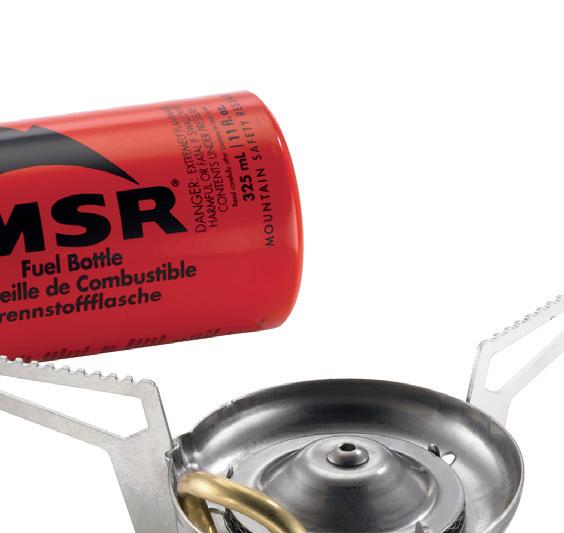


PRICE: £140 WEIGHT: 371G

PRICE: £215 WEIGHT: 384G
Designed as a workhorse stove for expeditions and ambitious adventures, the XGK EX will burn a wide range of fuels, from petrol and diesel to jet fuel, and do so reliably at altitude and in low temperatures. The retractable legs and pot supports give a stable base for a pan when extended but pack neatly for travel.
The Flash 2.0 is an all-in-one canister stove system that boils water fast. Its 1-litre cooking cup features a FluxRing base that’s optimised for efficiency. A push-button igniter makes firing it up quick and faff-free. Extras include a strainer lid and an insulated cosy with a colourchange heat indicator.



PRICE: £70 WEIGHT: 200G
Ideal for cooking on tricky terrain, the Express Spider is a remote canister stove boasting a stable burner and precise flame control. Lightweight and powerful, the pot supports lock in place for extra security and fold down compactly for trips where saving space matters.

PRICE: £55 WEIGHT: 73G
Don’t be fooled by its size - the PocketRocket 2 is a much-loved gas canister stove for good reason. The burner’s WindClip windshield helps maintain a solid flame, while the glove-friendly controls, lightweight design, and proven build quality make it an easy choice for minimalist adventures across the board.




Isère is home to some of the most stunning walks – and challenging runs – in the French Alps. Jen and Sim Benson experience both sides of the coin during a family trip to the Rocher Blanc Skyrace.

The 21km Skyrace is just one of the events at the French festival of running known as L’Échapée Belle.

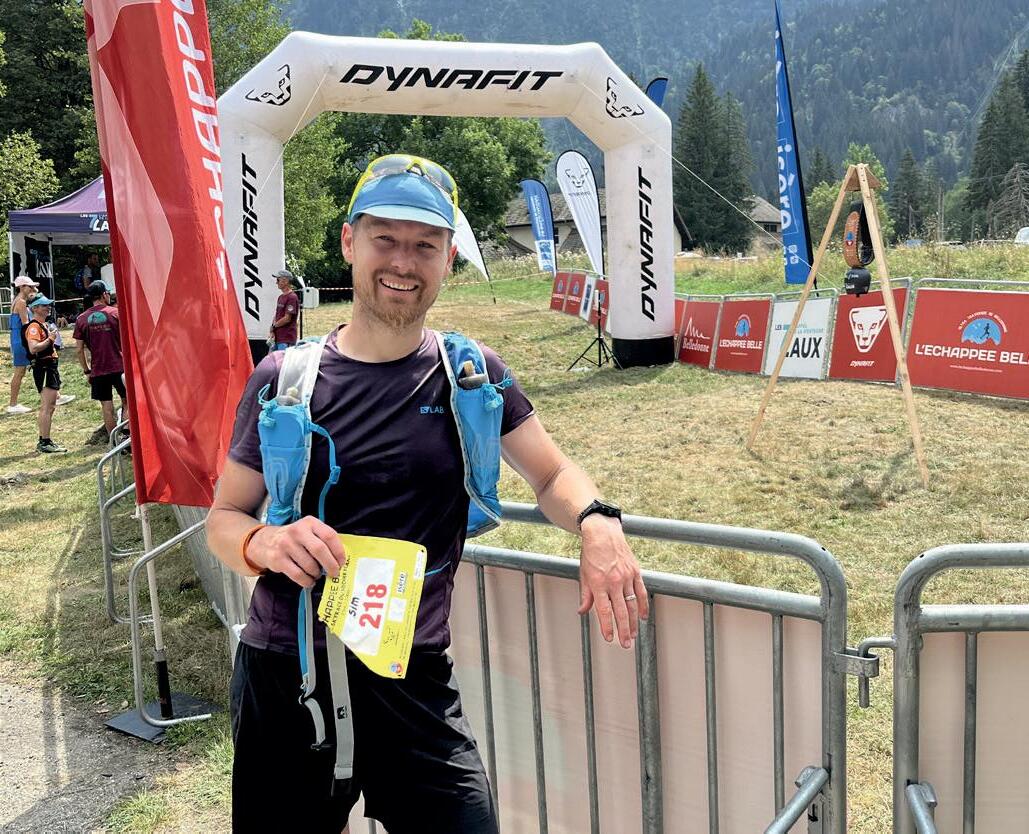
Sim Benson: A crowd of runners, underdressed for the early morning drizzle, gathers at the start of the Rocher Blanc Skyrace in Isère. Friendly chatter fills the air – mostly French, but there’s a mix of accents including the comforting Cumbrian tones of some Keswick AC runners, huddled together in their familiar yellow-and-green vests.
The tension’s building and I’m nervous but excited, keen to get going. I look up at the mountains – their airy spires and scree-covered flanks – and feel a shiver of anticipation. Music builds; the MC talks fast in French; runners jostle towards the start gantry. I stand a little way back from the front group. I’m feeling good, but I don’t want to start too fast and pay for it later. The countdown begins. Trois… Deux… Un… and we’re off.

Jen Benson: Located within the AuvergneRhône-Alpes, Isère takes its name from the river that flows through the department from a high glacier on the Italian border. With the city of Grenoble at its heart, it’s easily reached by road, rail or air from the UK. The region’s mountains span four massifs – the Belledonne, Chartreuse, Vercors and Oisans – each very different in character, but all outstanding year-round adventure destinations.
We’re here for L’Échappée Belle, an annual weekend celebration of mountain running in La Belledonne. Distances range from L’intégrale, which takes in the full traverse of the massif – 153km with a leg-sapping 11,390m of ascent – to the 21km Skyrace, tackling the shortest (and steepest) route to the summit of Rocher Blanc at 2,928m before plummeting straight back down.
Humans have been competing to conquer both themselves and each other in the mountains for centuries, but the idea of running to a summit for fun is far more recent. Skyrunning as an official discipline was developed by Italian mountaineer Marino Giacometti, pioneer of many Alpine records and races in the early 1990s. In 1993, with multinational group Fila as its main sponsor, the series kicked off with races in the Himalayas, the Rockies, Mount Kenya, the Mexican volcanoes and, of course, the Scottish Highlands – which was home to the world’s first competitive mountain run (the Ben Nevis Race) back in 1895. Now governed by the International Skyrunning Federation, the sport spans more than 400 races worldwide with over 100,000 participants from 65 countries.
If you’re keen to give it a go, the good news is that Skyrunning doesn’t require a lot

of specialist kit. To move quickly and safely through the mountains, you’ll need a pair of running shoes that combine high levels of precision, grip and protection. You’ll also need a race vest for carrying water, snacks, waterproofs and basic emergency kit, and a set of lightweight, foldable poles. Training on terrain similar to the race is essential, along with a good strength programme to build a strong, resilient body to cope with the extreme challenges involved.
SB: The start is fast and flat – the only flat stretch of the whole race. I worry I’m going too fast too soon – there’s a big climb and 21 technical and tough kilometres ahead – but soon we’re into the trees, the trail starts to climb and the pace drops. I get out my poles and settle into a rhythm, following the






“Skyrunning was developed by Italian mountaineer Marino Giacometti in the early 1990s”





winding line of runners up a steep, stepped trail through splendid Alpine pasture. After around 6kms, we reach Sept Laux – part of the Belledonne massif boasting a series of stunning mountain lakes and dominated by the 2,927-metre (9,603 ft) summit of Rocher Blanc. Which is exactly where we’re heading.
We leave the main path and cross a boulder field to reach the steepest section of the route, the Amiante Pass. I haul my way up the scree, hands-on, feet struggling for grip and dislodging rocks that tumble down the mountainside. After the pass, a short, precipitous descent loses 150m of hard-won height, only to regain it almost instantly on another vicious ascent. The exposure really hits here, the earth dropping away to either side of the narrow, rocky ridge that rises steeply to the high point of the race.
It’s a relief to reach the top, where there’s a welcome aid station and a few other runners. I take a few moments to stash

“It’s a treat to explore without the fear of getting lost”
my poles, refill my water bottles, eat some sweets and compose myself for the descent – 1,500m all the way to the finish. I check my watch – it’s taken me 2.5 hours to reach this point, and my goal is a sub-4hr finish. The race is on.
JB: If, like me, you’re not visiting the Belledonne to race, there’s a wealth of running, walking, rock climbing and cycling to enjoy, as well as mountain lakes to swim in and refuges for refuelling. Waymarked trails, including the GR 738 – the High Crossing of the Belledonne – lead straight from the Gîte de la Martinette (the chalet we’re staying in with the kids) into the surrounding forest and up onto open pasture and mountainside. It’s a treat to explore without the fear of getting lost, following the arrows or the bright paint splashed on rocks and trees on an undulating loop through verdant, high-level woodland nourished by the spray of waterfalls.
SB: I launch myself off the summit, running as fast as I dare over steep, pathless ground, picking a route between the orange markers. Over 1,000m of height vanishes in the first 4km of distance. My quads burn as I fight gravity, struggling to find the balance between chaos and control.
Eventually, we join a better path and the running eases a little. The final aid station
“It’s a place that lends itself beautifully to adventures, whatever pace you choose”
is at the Refuge de la Combe Madame, a brief plateau before the final 5km descent. I drink Coke and, buoyed by the sugar and caffeine, fly down snaking forest trails, feeling surprisingly strong. It’s only during the last couple of kilometres that I start to really struggle, each step a monumental effort, battling with almost overwhelming fatigue.
Just before the finish there’s a river crossing. I wade in, grateful for the numbing chill of the water on my trashed legs. I glance at my watch and notice my sub-4hr goal might still be possible – but only just. Hauling myself out, I throw everything at the last short hill, crossing the finish line and ringing the bell – an Échappée Belle tradition – before collapsing onto the grass, utterly done. When I can breathe again, I look at my time: 3:59:28.
JB: Back at the chalet we join some of the other runners for a celebratory dinner. It’s Dutch couple Hans and Lienke’s first experience of mountain running, and Hans in particular sports a kind of 1,000-yard stare. He was so far out of his comfort zone, he tells us. But the sense of achievement is clear.
On our last evening, we share a fondue with one of the other guests – a tiny Frenchman from a village close to the
As runners reenter the valley, thoughts turn to the finish line.

Pyrenees who’s staying a night on his traverse of the GR 738. He’s wild camped much of the way, but there’s a storm coming in. We talk about the route, which he highly recommends; about the wolves he’s heard but not seen; the patou – huge, white, and often terrifying shepherd dogs that guard the mountain sheep from the wolves; and the bears in his home region in the Pyrenees. He used to be a runner, but these days prefers to explore more slowly, taking time to enjoy the views.
I can certainly appreciate that approach. Reflecting on a few days in Isère – running, racing, walking and exploring, both alone and with the kids – it’s a place that lends itself beautifully to adventures, whatever pace you choose.
















PRICE: £85
WEIGHT: 134G
A good windproof delivers huge bang for buck in variable conditions. Salomon’s Bonatti Cross Hoody packs in the features, with a close-fitting hood, zipped chest pocket, and reflective details. Light and breathable, a waterrepellent finish enhances weather protection.















PRICE: £45
WEIGHT: 90G
A deceptively simple tee, the Cross Run is super-soft as well as being breathable and fast-drying thanks to the AdvancedSkin ActiveDry technology. Reflective branding adds visibility in low light, while raglan sleeves and a slim active fit allow a full range of movement whatever the challenge.






PRICE: £55
WEIGHT: 127G
This two-in-one design consists of a snugfitting boxer inner that reduces chafing, and a loose outer for breathability and freedom of movement. Two pockets give storage options (one zipped for keys and other small valuables), while the rear loop provides a hook to stash another layer.


PRICE: £145 WEIGHT: 363G

On longer runs when you want to carry extra kit, Rab’s 12-litre Veil makes a top choice. Streamlined and stable, its Mono Mesh Chassis reduces bounce while contouring to your body for a comfortable fit. Easy to stay hydrated on the go, there are two 500ml flasks that stow in the front pockets, and there’s room for a hydration bladder at the back. Bungees keep extra layers strapped down, while zipped pockets keep your keys, snacks, and phone secure.















PRICE: £180
WEIGHT: 340G
Featuring ultralight materials, the Distance Carbon FLZ pole is quick to set up thanks to its FlickLock Pro adjusters, while the three-section carbon pole and speed cone deployment is slick and effortless. A breathable and moisture-wicking strap and Padded foam grip give a comfortable grip without adding weight.






PRICE: £30
WEIGHT: 65G
When a simple handheld bottle fits the bill, the SkyFlask Speed offers a 500ml capacity with an ambidextrous strap and bite valve for easy rehydration on the move. Its Speedfill cap allows rapid refills, while the bottle itself is collapsible and can be stowed easily when empty.



PRICE: £120 WEIGHT: 222G
When tackling routes involving both trail and tarmac, the Ultra Flow comes into its own, with an EnergyFoam midsole reducing impact and a Contagrip 3.5mm lug rubber outsole for grip wherever it’s needed. Salomon’s footcradling SensiFit upper construction and breathable, recycled mesh fabric offer instant comfort and prevent hotspots on longer runs.





PRICE: £150 WEIGHT: 276G
The Challenger 7 will soak up whatever terrain you throw at it, from tarmac to trail and everything in between. A GORE-TEX Invisible Fit waterproof membrane adds weather protection without interrupting the fit, and a high stack gives a plush ride. Inspired by gravel tyres, the multidirectional lug pattern provides impressive all-surface traction.




PRICE: £140 WEIGHT: 269G
When heading off the beaten track, choose the Genesis. Lightweight but rugged, it thrives on steep descents and mountain ascents. The scree and debris-resistant woven upper is breathable, and the Quicklace lacing system gives a precise, easy-to-adjust fit. A Contagrip outsole with 5mm lugs finishes off this all-round technical package.















PRICE: £140 WEIGHT: 250G
An updated skyrunning icon, the Bushido III features a new FriXion bi-compound outsole and fierce lugs that guarantee maximum grip, stability and precision, whatever the underfoot conditions. The sock-like upper hugs the foot, with mesh panels for increased breathability. A supercushioned midsole absorbs impact and ensures comfort on long days.
PRICE: £175 WEIGHT: 320G
When precision and stability are paramount, the Kalibra ST is the answer. Its Sock Fit construction and Wrap360 lacing system – developed with BOA – gives a micro-adjustable fit. The robust rand protects against sharp rocks and abrasion, while the grippy sole unit with 6mm lugs ensures traction on soft, technical ground.































PRICE: £150 WEIGHT: 235G

Blending eye-catching design with oodles of practicality, the Cloudsurfer Trail achieves high energy return thanks to the CloudTec Phase cushioning and rockerstyle action. Coupled with the shock-absorbing technology of Helion superfoam, it gives an optimal combination of stability and comfort. The Missiongrip sole performs in the wet and dry, ideal for daily runs with road-to-trail transitions.



Calum Muskett introduces the joys of scrambling.
It’s a spring evening on Skye’s famous Cuillin Ridge. There’s barely a breath of wind and I can hear the cry of seagulls coming up from Glenbrittle. I’ve just traversed from Sgùrr Alasdair to Sgùrr Dearg, one of the finest ridgelines in the UK. Standing atop the Inaccessible Pinnacle I can see the Outer Hebrides to the west and Rum and Eigg to the south. There’s not another person in sight. A couple of hundred metres below, I spot a possible launch site for my paraglider. Carefully retracing my steps down the ‘In Pinn’, I collect my gear and cross over to a small oasis of flat amongst the rocky landscape. A simple launch in calm air and I’m gently floating back towards the valley, taking the easy way down to land on the beach next to the campsite.
With or without the aerial descent, scrambling provides a beautiful way of enjoying the mountains. It takes you on interesting routes through rugged terrain, it’s free of charge, and it adds an element of fun adventure to your day out. Here are my top tips.
The UK is blessed with excellent scrambling across much of the country due to the craggy nature of our hills. Perhaps the finest routes in the land can be found in the Cuillin hills on the Isle of Skye, but my other favourite destinations for longer and more sustained scrambles are Torridon, Ben Nevis, Glen Coe and Eryri.
There’s a huge amount of information available online. When researching routes, look for a description alongside a topo image (a photo of the scramble with the line it takes highlighted) to help identify the right way to go. The Scottish Mountaineering Club have also produced some excellent scrambling guides which you can pick up in print, whilst in Cymru, Garry Smith’s ‘North Wales Scrambles’ is a great introduction to the area.
Scrambling in the UK is generally assigned a difficulty level from Scramble Grade 1 (SG1) through to SG3. SG1 feels like adventurous hill walking. The difficulties are
Calum Muskett is an IFMGA mountain guide and a professional climber. He spends most of his time in the mountains – whether on skis, running, climbing or biking – and loves to share his passion for the outdoors with others.
often short and stepped, but be aware that there can be a great deal of exposure. Some of the most classic SG1’s in the UK are Crib Goch in Eryri, Striding Edge on Helvellyn and Càrn Mòr Dearg on Ben Nevis.
Routes graded SG2 tend to have more sustained difficulties, where one scrambling step leads to the next, and they occasionally involve some challenging route finding. SG3 is the borderline between scrambling and proper climbing; parties will typically use a rope and climbing equipment to safeguard these sections. Classic examples of SG3 include Bilberry Terrace on Lliwedd, Cneifion Arete on Glyder Fawr and Curved Ridge on Buachaille Etive Mòr.
The UK’s more popular scrambles are well travelled, so once you’re on the route then signs of wear and polish on the rock and small ‘sheep’-type paths along terraces are tell-tale signs you’re going the right way. The inverse is evident when you stray off-track –including loose-feeling holds, unexpected difficulties and large amounts of vegetation.
For the majority of scrambling, all you need is a helmet and a good set of approach shoes or boots with a sticky/rubber sole. Having the right footwear will make a huge difference to your enjoyment and security –look out for scuff protection, straight edges that are close to the toes (rather than a splayed edge) and a stiff, grippy sole such as Vibram.
For more difficult scrambles, you might consider wearing a light harness and carrying carabiners, a small climbing rack with slings and nuts, and a climbing rope

between 30 and 50 metres in length. Bare hands are usually best since you get more feedback from holds and can apply more power, but in cold conditions a set of thin, leathery gloves can be useful.
Scrambling can be enjoyed throughout the year and you can adjust the level of difficulty to match the conditions. Winter scrambling can be especially enjoyable, but you’ll need an understanding of how winter conditions can change the difficulty of terrain, as well as experience using crampons and an axe.
Guided scrambling is available through private providers and centres in all the hillier regions of the UK. Look out for qualified IFMGA British Mountain Guides or AMI instructors. But while this is a great way to kick start your scrambling skills, you can also gain experience by yourself; start on lower graded scrambles and methodically work your way up to more challenging routes if you so choose.
The majority of scrambling in the UK is completed un-roped, so a fall in the wrong place can be serious or fatal. Always make sure that you can downclimb what you’ve climbed up, and gradually build up knowledge over time to ensure good route-finding ability. Lastly, be careful not to knock rocks on those beneath you – while being mindful of rockfall from above!
In scrambling, and indeed climbing, good footwork and tactics are the key to making upward progress. Look for small, flat edges on which to place your feet, watching your toe all the way onto the hold, and use the toe area of your boot or shoe. This might sound obvious, but when teaching beginner and intermediate level scramblers I’m often surprised by the overuse of the side of their boots, and although people are good at identifying holds, they rarely place their feet carefully and end up having to pull harder than necessary with their upper body.
It’s also good to think about ‘opposition’. Not all handholds will take a downward pull, so when pulling sideways remember to use opposite force from the feet. (It can help to imagine trying to open an elevator door with both hands – pulling on one side while your feet push against the other!)
There is no magic pill for overcoming a fear of heights – indeed it’s a perfectly natural response! Intermittent exposure to heights and keeping away from your ‘panic zone’ will, over time, build your confidence so that you can enjoy scrambles that were once daunting.
Although it helps with speed and recovery, a high level of fitness is not necessarily required. You just need to be ‘hill fit’ with plenty of walking experience. This is an activity that can be enjoyed by many and doesn’t need to be completed quickly, as long as you’ve set off at an appropriate time with a good forecast.









“THERE’S NO MAGIC PILL FOR OVERCOMING A FEAR OF HEIGHTS – INDEED IT’S A PERFECTLY NATURAL RESPONSE!”



















PRICE: £210
Full-featured, tough, and with just the right capacity, the 30-litre Talon Pro packs a lot in. NanoFly fabric and an injection-moulded frame sheet ensure comfort and durability without pushing the weight. Helmet carry, stash pockets, and tuck-away ice axe attachments boost the potential cargo configurations.














SKYE’S CUILLIN RIDGE TRAVERSE
PRICE: £20
SCRAMBLES IN THE LAKE DISTRICT - SOUTH
PRICE: £19
SCRAMBLES IN SNOWDONIA
PRICE: £17
Arguably the definitive scrambling guides to these classic mountain areas, Cicerone’s books are packed full of local knowledge. Covering everything from inspiration on where to head, historical points of interest, and practical, accurate route finding guidance, you’ll appreciate them just as much mid-scramble as you will when planning the trip.


PRICE: £180
The TX4 inspires confidence on technical terrain. Its climbing shoe style laces give a precise fit, while the Vibram Megagrip Impact Brake System sole gives proven traction and descent capability. Made with recycled materials and a bluesign approved GORE-TEX liner, the TX4 is designed to be easily re-soled.









PRICE: £67
A versatile harness, the Corax is easy to adjust for whatever climbing activity you fancy, from indoors to sport, multi pitch to scrambling. Its supportive waist belt and padded leg loops distribute weight evenly for comfort on longer belays, while five gear loops provide plenty of room for your climbing rack.








PRICE: £58
A tried and tested classic, the Half Dome offers reliable protection and all-day comfort. Its low-profile suspension system and one-handed fit adjustment give a secure fit, with room to wear a thin beanie underneath in colder weather. Vents offer cooling when it’s warm, and side clips keep your head torch secure.



PRICE: £23
Incredibly strong but still lightweight, the ability to extend a runner in seconds makes the Alpine particularly valuable on multi-pitch routes. Phantom carabiners at the ends have wire gates to minimise iceclogging issues, and the different colour biners and rope groove extend rope life too.






Keen to try scrambling for yourself?
Our staff pick five of their favourite UK routes.

THE NORTH RIDGE OF TRYFAN
ERYRI NATIONAL PARK (SNOWDONIA)
Andy Barlass: Customer Services
Difficulty: Grade 1
(Easy/Intermediate)
Exposure: Low
Tryfan’s North Ridge offers one of the best days out in the UK. The scrambling begins almost as soon as you leave the road, working your way up any one of several routes towards the summit. With incredible rock formations such as the Cannon (don’t forget your camera!) and Adam and Eve, Tryfan has something for everyone. With nice dry rock, it can also be combined with Bristly Ridge on Glyder Fach for an even bigger challenge.


Ry Phillips: Aviemore
Difficulty: Grade 2 (Intermediate/Advanced due to length)
Exposure: High
This spectacular-looking hill offers breathtaking views of Loch Torridon and the mountains of the Northwest Highlands. The 8km ridge connects two Munros – Spidean a’ Choire Leith (1,055m) and Mullach an Rathain (1,023m) – and weaves over or around the famous pinnacles of Am Fasarinen. While the harder scrambling on beautifully rounded sandstone tends to be optional, the sense of precarious height certainly isn’t. At 6-8 hours long and with few feasible lines of escape, it’s a committing route. Be sure to stop by the Torridon Inn for a victory pint!
The views around Loch Torridon simply can’t be beat.

Louis Hunt: Fort William
Difficulty: Grade 1 (Easy)
Exposure: Medium
Ogwen Valley is home to a vast network of paths and mountainous terrain. One personal favourite is the hike up to the shore of Llyn Idwal, and the subsequent easy scramble towards Y Garn via the ‘sheep path’. Along the way you can take in some of the most dramatic views of Cwm Idwal imaginable; even an overcast day looks spectacular here! For those wanting to test themselves, the Grade 3 Devil’s Kitchen Scramble is also accessed along Llyn Idwal, but be warned – this leads into a graded rock climb so is for experienced climbers only.
Clarice Shuhang Cao: Covent Garden
Difficulty: Grade 1 (Easy to intermediate according to the season)
Exposure: Medium
This is a fantastic all-season ascent to the summit of Ben Nevis. As you walk along the ridge, you’re treated to an increasingly stunning panoramic view of the famous North Face and the mountains of the Mamores and Glencoe. With the right gear it’s suitable for winter climbing, and you can scramble here all year round; trail running is another good option. Fort William is located within walking distance near the bottom of the Munro (at the end of the West Highland Way hiking route) so you can toast your mountain adventure with a beer at one of the many local bars.
“This scramblecome-climb takes possibly the most dramatic route up Ben Nevis”
Eleanor Harper How: Fort William
Difficulty: Grade 3 (Advanced – more of a climb)
Exposure: High
This scramble-come-climb takes possibly the most dramatic route up Ben Nevis. At around 600m of ascent, it’s a brilliant and adventurous way to spend a day. I love the exposure and pure scale of the ridge, which cuts a straight line up the North Face of the Ben – and you can’t beat the feeling of popping up from this isolated climb onto the busy summit plateau. It’s quite a contrast, and certainly makes you feel a little smug that you’ve avoided the crowds. For the descent, you can finish where you started or – my personal favourite – head to the Ben Nevis Inn in Glen Nevis.



PETZL WOMEN’S BOREA
PRICE: £62
A women’s specific helmet for climbing and mountain pursuits, the Borea is lightweight but comfortable thanks to the dual foam liner and Omega headband. The latter has a notch to accommodate a ponytail, and the headband folds into the shell for transport and storage.
SCARPA WOMEN’S ORIGIN VS
PRICE: £110
A neutral shoe for extended wear without discomfort, the Origin VS has a relaxed toe position and a large soft rubber toe patch that lends itself to hooking. The heel features Scarpa’s Power Absorbing Fit system for better fit and confidence-inspiring tension, while the single velcro strap makes donning and doffing a rapid matter.
GORILLA GRIP 6OZ
PRICE: £16
A light dusting of chalk is an essential climbing aid, whether you're indoors or outside. This loose magnesium carbonate chalk is a hassle-free way to refill your bag, is suitable for all skin types and comes in a fully recyclable box.

















PRICE: £145
DMM’s Aether quickdraws perfectly balance strength and low weight. The carabiner’s I-Beam construction shaves grams without compromising structure, while the clean nose avoids snagging. Light and versatile, this 6-pack sees them mounted on 12cm long 11mm Dynatec Dyneema slings.










PRICE: £58
A real all-rounder, the Momentum features an astonishingly comfy dual-core design waistband and good leg loops for longer sessions, as well as four gear loops for trad gear or quickdraws. The leg loops are adjusted via BD’s trakFIT system, which uses a slide adjuster for quick and easy fitting.




































PRICE: £115
If there’s a noticeable weight difference between you and your climbing partner, add the Ohm to your kit. An assisted-braking resistor, it increases rope friction without affecting handling. If the heavier climber falls, it stops the belayer from being pulled into the air, reducing chances of injury.




PRICE: £160




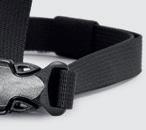
PRICE: £35
A true workhorse, the Circuit Crash Pad is easy to transport thanks to the hinge fold, and the squared edges let it pair up with other pads for perfect coverage of your highball project. The build is robust, with closed-cell PE foam layup and an EVA bond absorbing the biggest of impacts.
The Ion offers a superlight take on a standard chalk bag. Its spiral closure opens wide and closes tight to make chalking up easy. An adjustable belt and brush loop tick off the essentials. Made with a bluesign approved siliconised construction that’s water-resistant, it stands up to frequent use.

Bristol assistant manager Jay Doy shares a few of his favourite outdoor destinations in the beautiful West Country.



Literally around the corner from the Bristol store, the Downs are a hub for sports and fresh-air activities. Just beyond them lies the Avon Gorge, home to Brunel’s famous bridge and a local climbing hotspot. Routes up the limestone include names like ‘Suspension Bridge Arete’. My favourite time to visit is at sunset, when you get an amazing view from the observatory.
Crossing no fewer than three counties, the River Avon Trail runs from Pill in North Somerset, through Bristol city centre, and then on to Bath. It’s suitable for adventures on foot or by bike, with several sections offering a choice of path types. You can jump on and off the route at will, and there are some great pit stops along the way – including my own fave, the Chequers Inn.
Name: Jay Doy
Store: Bristol
Main activities: Cycling, cycling, more cycling. Sometimes I run or hike too!
Part of team Ellis Brigham for: 1.5 years
The UK’s answer to the Grand Canyon... or that’s what they say. The Circular Walk takes you along the ridges on both sides, dipping down into the village of Cheddar and – at the other end – Black Rock. The gorge is also a cycling magnet thanks to its iconic road climb. Head to the year-round Christmas shop in the village, climb Jacob’s Ladder, or just stock up on cheese. But beware the wild goats!
Just across the border over the Severn Bridge, the Welsh ‘mountains’ await. Bannau Brycheiniog is great for all sorts of adventures – it’s even hosted some skiing recently! The beautiful peak of Pen y Fan has several routes up for different abilities. My own favourite, the horseshoe route, features a big climb at either starting point to get the blood pumping and is great for trail running.


Striking that balance you only dared dream of: All the comfort and cushioning of Energy Foam backed up by the dynamic support of the Active Chassis. Send it, with confidence.
The weaved Matryx ® upper is scree and trail carnage-resistant, long-term durable and breathable.
All-Terrain Contagrip ® compound, a unique, two-part lug pattern and the raised tread offer an adaptable, secure grip even in sketchy situations and changing terrain.











